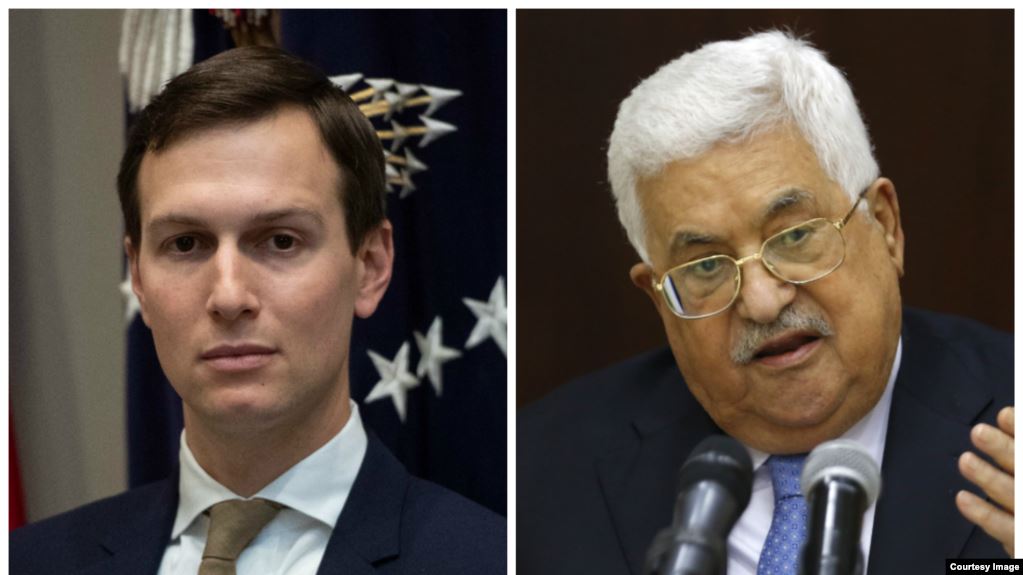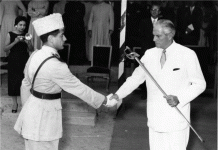Rock, Paper, Scissors in the Middle East
Tony Badran/Tablet Magazine/February 04/2020
طوني بدران/موقع تابليت/ قراءة في صفقة القرن: صخرة وورقة ومقص في الشرق الأوسط
Trump’s is the latest play in a decadeslong game of trying to counter previous ‘peace process’ moves by each new American administration.
President Donald Trump has finally unveiled his 180-page vision for peace between Israel and the Palestinians, which came as a sweet balm to Washington think-tankers and Middle East opinion writers, who had been slumbering like Rip Van Winkle, waiting for a chance to rise and display their dilapidated peace-processing expertise. As if no time had passed between 1995, or 1999, or 2004, or 2007, and the present, they got right busy determining whether the president’s vision was indeed realistic and viable, and whether it measured up to the accumulated history of American peace processing, and whether it was “fair” or “just” to the Palestinians, and whether it might just “bring both sides back to the table,” and on, and on, and on.
After all, the parameters for a “final settlement” between Israelis and Palestinian Arabs have long been clear: The so-called Clinton Parameters—named after former President Bill Clinton, Hillary’s husband, who had the good fortune of serving his two terms during the short, sunny period between the end of the Cold War (1946-1989) and the beginning of the decadeslong Global War on Terror (2001-the present).
The Clinton Parameters were the summa of President Clinton’s approach to foreign policy, which, in the absence of any larger dragons to slay, sought to perform important good deeds like making peace between the British and the IRA in Northern Ireland, and Israel and the PLO in the Middle East.
All we needed to achieve peace in the Middle East, the wise peace processors of the Clinton years told us, was the courage to finesse a few small remaining areas of disagreement, which required having the right leadership in Israel and Palestine. They also required trust and confidence-building measures, including a freeze on Israeli settlement activity.
Those were the days, my friend. The days of wine and roses, and of heroes like Robert Malley.
Yet, despite the parameters being so simple, obvious, and apparently easy to achieve, the peace process shockingly never went anywhere. Instead, it degenerated into the violence of the second intifada, which wasn’t led by Yasser Arafat; except, of course, that it was. After Arafat died in 2004, elections were duly held among the Palestinians, who elected Hamas, which chose rockets over suicide bombers after the Israelis left Gaza—a move that was supposed to bring about peace, but of course did nothing of the kind. Bill Clinton blamed Arafat.
Malley and the New York Review of Books blamed Israel for not conceding enough fast enough to the Palestinians at Camp David, and for passing the baklava from left to right instead of from right to left.
Nearly a decade later, Condoleezza Rice tried her hand at “bringing peace,” and came up empty; a decade after that, so did John Kerry. Apparently, the box containing “peace” was empty.
Architects of the peace process today openly declare the entire enterprise hopeless. In a recent op-ed in The Wall Street Journal, former U.S. Special Envoy for Israeli-Palestinian Negotiations Martin Indyk, a dedicated servant of peace, wrote about his participation, six years ago, in the last direct Israeli-Palestinian negotiations, which were conducted under the wise auspices of John Kerry, who had once promised that solving the core problem of the Middle East would take him nine months.
“At the end of that nine-month encounter, the two sides were farther apart on all the core issues than when we started,” Indyk wrote. Showing some degree of late-blooming insight, he finally admitted that the two-state solution was “not a vital American interest.”
As far as the United States is concerned, there are no more disputed territories: The land is Israel’s.
Other peace processors had despaired of the Palestinian track much earlier. Take the Wilson Center’s Aaron David Miller, for instance.
In a 2008 Washington Post op-ed, Miller, showing greater wisdom than Indyk, advised then president-elect Barack Obama to set aside Israeli-Palestinian peace. “There’s no deal there,” he wrote.
This being Washington, though, Miller then urged Obama to pursue another fantasy based on one of the peace process industry’s key pillars, the 1967 lines.
This fantasy was the Syria track: Instead of brokering negotiations between Israel and the recalcitrant and divided Palestinians, the United States should spend its vast diplomatic energy and capital brokering an agreement between Israel and Syria that would “return” the Golan Heights to Syrian dictator Bashar Assad.
This advice would have resulted today in the Islamic Revolutionary Guard Corps (IRGC) controlling the Golan Heights, and probably in a shooting war.
Obama, who was smarter, if not wiser, than Indyk and Miller combined, took zero personal interest in the Israeli-Palestinian peace process per se.
Rather, he used the “peace process,” now in quotes, as a form of Kabuki theater, which served to keep the Israelis busy and off-balance while he implemented his broader regional strategy of realigning with Iran and downgrading traditional allies.
Demands for a settlement freeze were a useful cudgel to wield against Israel, and so were the threats of a unilateral announcement of new American parameters (which never happened) and unfavorable resolutions at the United Nations (which were threatened for years before finally being delivered).
At the end of December 2016, before he left office, Obama affirmed the 1967 lines—and by extension, the position of Israel’s enemies—by orchestrating the passing of United Nations Security Council Resolution 2334.
The resolution called upon all states “to distinguish, in their relevant dealings, between the territory of the State of Israel and the territories occupied since 1967,” and reaffirmed that all Israeli communities established in territory “occupied since 1967, including East Jerusalem, have no legal validity.”
As with UNSCR 2231, through which Obama sought to lock in his deal with Iran, UNSCR 2334 sought to replace congressional authority with an international “rock” that would tie his successor’s hands and box him in within Obama’s regional preferences.
President Trump is also thinking geopolitically, only from the opposite side. A main purpose of his “Deal of the Century” is to strengthen Israel’s security and also, as the White House noted explicitly, to foster “strong regional partnerships to counter Iran and terrorism,” namely between Israel and the Gulf states.
In other words, in the game of rock, paper, scissors that Trump appears to be playing with his predecessor, the peace plan is Trump’s “paper,” which counters the “rock” that Obama tossed through Israel’s window on his way out the door.
To that end, the president has used a series of tools to dismantle Obama’s Middle East framework. Trump withdrew from the Iran deal in May 2018, collapsing the security partnership Obama had assiduously built with the Iranians and their regional militias commanded by the recently departed Iranian general Qassem Soleimani—who met his demise courtesy of a U.S. missile strike last month. This was the “scissors,” which countered the “paper” of the Joint Comprehensive Plan of Action, or JCPOA.
On the Israel front, Trump nullified the 1967 lines, the cornerstone of the Arab rejectionist position that Obama had attempted to enshrine in UNSCR 2334. He did this by moving the U.S. Embassy to Jerusalem, and then by recognizing Israeli sovereignty over the Golan Heights.
The latter move eliminated the 1967 framework altogether with regard to Syria and Lebanon. As far as the United States is concerned, there are no more disputed territories: The land is Israel’s.
The current plan extends that same approach to the Jordan Valley, in addition to existing settlements. “If the State of Israel withdrew from the Jordan Valley, it would have significant implications for regional security in the Middle East,” the president’s vision states, expressing a positive desire for Israel to remain there.
An extension of Israeli sovereignty over the Jordan Valley would therefore serve U.S. regional security interests. Rock, Paper, Scissors.
Saudi Arabia and the United Arab Emirates’ acceptance of the Trump plan as the basis for any future talks between Israel and the Palestinians indicates that the United States’ regional allies have accepted the president’s nullification of the 1967 lines framework.
The significance of this is that the Saudis and the Emiratis have accepted that the starting point for any movement going forward is not the so-called Arab Peace Initiative, which the Saudis originally sponsored almost 20 years ago, and which has subsequently been loaded with additional rigid language, especially regarding the so-called right of return for Palestinian refugees, by rejectionists led by the Assad regime. The Trump peace plan is the new starting point.
The truth is, none of these frameworks matter anymore. Trump has made it clear that he is not bound by the fantasies of previous American peace processors—who today show contempt for the president’s plan even as they admit their own decades-long failure.
Trump’s deal is designed to underscore Israel’s special relationship with the United States—and it slams shut the rusty gates of the peace processing factory for good. It doesn’t much matter how the Palestinians respond. The American position is not dependent on the outcome of future negotiations.
Israel’s political class now has a clear window in which to determine its own fate. Israel can then live with the consequences of its own choices.
*Tony Badran is a research fellow at the Foundation for Defense of Democracies. Follow him on Twitter @AcrossTheBay.






















